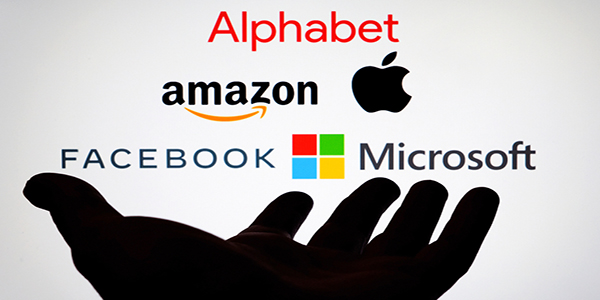 |
||||||||||||
|
||||||||||||
| Google Fights Back Against DOJ Antitrust Case |
 |
| Two giant entities stand on opposite sides of an antitrust lawsuit — Google and the DOJ. In January, the DOJ sued Google for allegedly monopolizing the digital advertising market, marking the second time they sued the tech giant. Google’s response shows that they aren’t going to lie down and take it. Google asked the DOJ to drop the case as it aims to shut down one of its primary sources of revenue. The lawsuit, backed by eight states, demands that Google break down its ad tech business. Google’s primary argument against the antitrust lawsuit is that the DOJ’s case ignores the company’s biggest online advertising rivals and fails to meet the legal threshold for alleging a monopoly. “The DOJ’s lawsuit does not reflect the dynamic digital advertising industry and ignores key players we compete against every day,” said Dan Taylor, Google’s vice president of global ads. “The DOJ’s lawsuit is wrong on the facts and the law, and we will continue to defend against it in court.” The key players Taylor mentions include Meta Platforms Inc., Amazon.com Inc., Microsoft Corp., and TikTok. The DOJ has specifically accused Google of anticompetitive conduct: Acquiring Competitors: Engaging in a pattern of acquisitions to obtain control over essential digital advertising tools used by website publishers to sell advertising space; Forcing Adoption of Google’s Tools: Locking in website publishers to its newly-acquired tools by restricting its unique, must-have advertiser demand to its ad exchange, and in turn, conditioning effective real-time access to its ad exchange on the use of its publisher ad server; Distorting Auction Competition: Limiting real-time bidding on publisher inventory to its ad exchange and impeding rival ad exchanges’ ability to compete on the same terms as Google’s ad exchange; and Auction Manipulation: Manipulating auction mechanics across several of its products to insulate Google from the competition, deprive rivals of scale, and halt the rise of rival technologies. |
| Google's monopoly is under siege. The DOJ is not the first to accuse Google of monopolizing the ad tech ecosystem. Members of the ad tech community have called out Google for dominating the ad tech industry for years. When the DOJ first filed the lawsuit in January, many felt strongly that the DOJ would succeed in its antitrust case. CafeMedia's Chief Strategy Officer Paul Banister speculated what the ecosystem would look like if the antitrust lawsuit were successful. "Google's publisher business would be forced to compete differently than it does today. It's possible this could open up AdX to run outside of GAM — a prebid adapter might be offered," said Bannister. "The sell-side would equally benefit: there would seem to be no reason that DV360 would continue to bias towards AdX. DV would be freed to bid more aggressively into other ad exchanges, which could create real pricing pressure on ad exchange fees, as pricing does drive performance." On the other hand, Google was right about the DOJ not acknowledging its rivals. The term Trioploy does not describe Google alone. It was designed to represent a three-headed monster — Google, Meta, and Amazon — who soak up a lot of ad spend in the ecosystem. Google and Meta hoarded around 85% of ad spend for a while before privacy regulations overtook the industry. How will this play out? It's too early to tell, but the DOJ is on an antitrust warpath. Last week, they filed an antitrust lawsuit against the Global Alliance for Responsible Media (GARM). According to GOP chair Jim Jordan, the group's "conduct reduces consumer choice and cuts off access to diverse coverage on matters of national interest." |
|
| Creating Ethical Frameworks for Decentralized Tech |
 |
| Decentralized tech heavily defines the next phase of digital media. DSTs such as Web3 and Blockchain can change how publishers and consumers use the internet. Yet, regulating this tech has been a problem for the digital media industry. For example, the collapse of FTX on the blockchain was a wake-up call. The cryptocurrency exchange that used blockchain technology was ripe with brand safety issues, such as the absence of records, accounting controls, and transparent decision-making processes. Instances like this exemplified the necessity for an ethical framework to use DSTs. From this belief, a partnership blossomed between the Brown University School of Public Health and the Edmond & Lily Safra Center for Ethics at Harvard University called the Justice, Health, and Democracy Impact Initiative. The initiative analyzes AI ethics and bioethics frameworks to determine how to regulate DSTs. They ask questions such as: How to use the data to generate predictions? How will institutions use the predictions? Who makes these decisions, sets the timeline, and establishes the criteria? In addition, they are deciding if DSTs are a significant enough transformation to cause a constitutional shift in society. Do federal regulations need to be implemented for the tech? |
| Federal regulators in Europe and the U.S. have already created a task force to regulate the emergence of generative AI. The White House and the European Commission partnered to determine how generative AI will evolve and to ensure brands use the tech ethically. And then there's the EU AI Act, the first law on AI proposed by a major regulator, which seeks to mitigate any risks the tech could potentially cause individuals or society. The Justice, Health, and Democracy Impact initiative attempts to achieve the same with DSTs. Web3 "leverages blockchain technology to create an inclusive web where people are part of the value exchange and have control over their data and privacy." But how do you regulate a decentralized technology? In this web phase, decentralization shifts data storage from one central system to a multitude of systems. For the advertising ecosystem, this switch can be beneficial. Some laud that DSTs will allow publishers and advertisers to build closer relationships with their consumers because they can collect data from them directly instead of a third party. Vitaly Gerko, CPO and Co-Founder at OTM, a technological programmatic platform, insists that "to stay relevant and successful in Web3, brands must build closer relationships with their consumers. In this new iteration of the internet, catching users' attention will require more effort, but at the same time, Web3 will provide more opportunities to build tighter connections with the consumer." While some laud the benefits of decentralization, the Justice, Health, and Democracy Impact initiative worries about its ability to create division and marginalize specific consumers. They see room for growing bias in datasets — albeit this is already an issue in Web 2 — and the ability for data to be trained on this bias and replicate the pattern. DSTs also need regulations for privacy concerns, data protection, and transparency. |
| How Industry-wide Cooperation Can Help Marketers Avoid IVT |
 |
| Recently, the Trustworthy Accountability Group (TAG) released its fourth annual fraud benchmark report for the Asia-Pacific market. The analysis, conducted by the 614 Group, shows the value of industry-wide cooperation in tackling difficult problems. In this instance, cooperation can lead to nearly negligible levels of invalid traffic (IVT) — if every partner in a transaction is TAG Certified Against Fraud, the IVT rate plummets to just 0.56%, well below the estimated global industry average of 11.5%, as well as the 1% threshold that many brands today expect. To calculate the APAC Fraud Benchmark, the 614 Group examined 183 billion impressions for campaigns in eight APAC markets in 2022, bucketing them into sophisticated IVT (SIVT) and general IVT (GIVT). TAG’s Certified Against Fraud Program (‘TAG Certification’) focuses on combating both sophisticated IVT (SIVT) and general IVT (GIVT) across the digital advertising supply chain. The program sets industry best practices and allows companies to publicly communicate their commitment to helping brands avoid IVT throughout the ad ecosystem. For the first time, the annual TAG Asia-Pacific Fraud Snapshot report also includes a special section on IVT rates in China. In 2022, according to the report, China has an overall IVT rate of 5.93%, which is about 50% lower than the estimated global average. “The addition of China to the TAG research study and the collaboration between Chinese oversight organizations and TAG marks a watershed moment in the global efforts to make digital advertising safer and more valuable," explained Rob Rasko cofounder and CEO of the 614 Group. |
| Fraud and IVT have been a thorn in the side almost since the first digital ad was placed in the 1990s. By 2010, stories of fraud appeared in the popular press, leading brands to believe that they were wasting their money. Brands were told that up to 51% of ad traffic was fraudulent, which undermined faith in the industry. TAG was formed in part as a consortium to respond to this challenge. As more publishers, SSPs, DSPs and agencies achieved TAG Certification, the percentage of IVT in campaigns steadily declined. But there’s a rub. The 0.56% IVT rate is only possible when campaigns run through TAG Certified Channels, meaning all entities involved in the transaction (media agency, buy-side platform, sell-side platform, publisher) are certified. The 614 Group found that the IVT rate for traffic that is filtered (but not TAG Certified) is 0.93%, which is still below the 1% threshold that many buyers demand, but still 66% higher than fully TAG Certified Channels. APAC advertisers want low rates of fraud, but they aren’t always willing to pay for IVT detection and mitigation services. As the report notes, “??In some of the markets, CPMs are so low that asking clients to pay an additional sum for verification represents a substantial increase in the cost of inventory in those markets.” If CPMs in a smaller market hover sound $.20, paying an additional $.05 for verification services seems unreasonable to advertisers. Convincing regional advertisers to pay for verification can be an uphill battle, especially in regions where the TAG Benchmark is widely known. “Many marketers have a false sense of security. They hear the 1% and think IVT isn’t a problem, so there’s no need to pay for verification or to get certified. We need to educate them that the 1% is only possible when transacting in TAG Certified Channels,” said Rasko. |
| Around the Water Cooler |
 |
The America Act: Digital Advertising Competition Bill The digital advertising monopoly wars rage on as Sen. Mike Lee introduced a law to restore and protect competition in digital advertising. The goal is to eliminate conflicts of interest that have allowed platforms like Google and Meta to manipulate ad auctions and impose monopoly rents on a broad swath of the American economy. (AdExchanger) Google’s Ad Safety Report Reveals the Rise of Bad Actors When Google released its transparency report following strict government scrutiny, the tech behemoth revealed the company removed two billion more ads this year than in previous years. Bad actors rose in droves, as Google reported that 1.36 billion ads analyzed fell into the “abuse the ad network” category. (Digiday) Is CTV Really a Booming Industry? According to long-time CTV advertising proponent Brian Wieser, television advertising is turning downward. "Penetration continues to fall at a dramatic pace and is poised to decline below 50% in the United States probably towards the end next year (down from more like 90% at the beginning of the last decade)," said Wieser. (MediaPost) Publishers Uses Generative AI to Publish Thousands of Posts Ingenio integrated OpenAI’s GPT-3 technology into its content management system at the end of 2021. Since then, they have used the tech to write over a thousand evergreen posts. In the near future, they will launch a chatbot that gives readers spiritual guidance. (Digiday) |
 |
|||
|
|||
 |
|||
 |
|||
|







